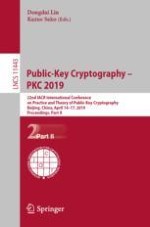
2019 | OriginalPaper | Chapter
Collusion Resistant Broadcast and Trace from Positional Witness Encryption
Authors : Rishab Goyal, Satyanarayana Vusirikala, Brent Waters
Published in: Public-Key Cryptography – PKC 2019
Publisher: Springer International Publishing
Activate our intelligent search to find suitable subject content or patents.
Select sections of text to find matching patents with Artificial Intelligence. powered by
Select sections of text to find additional relevant content using AI-assisted search. powered by